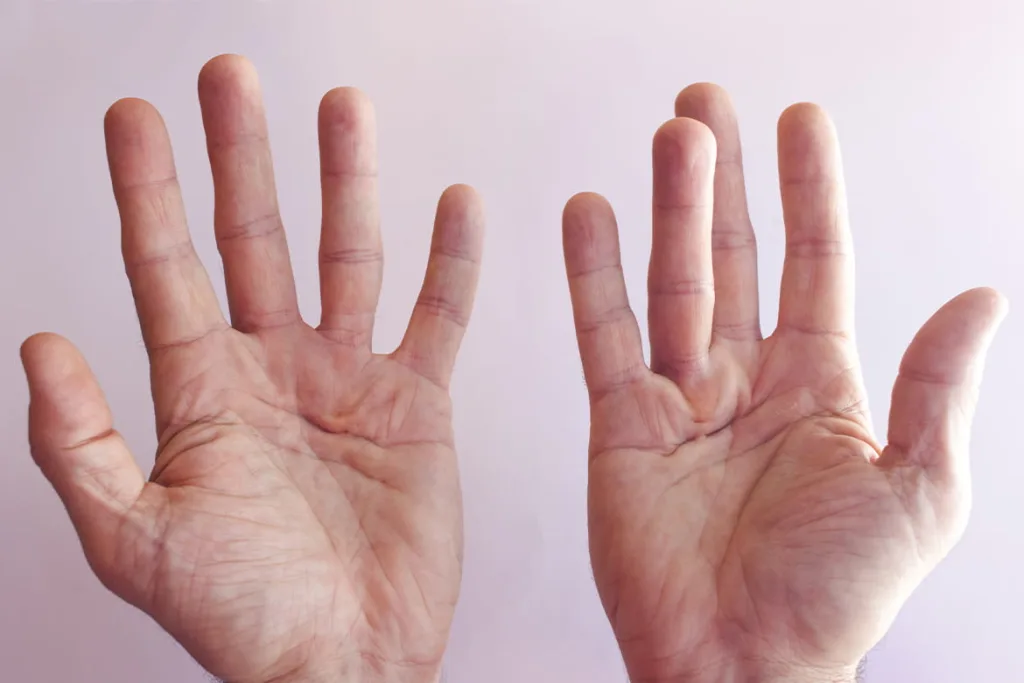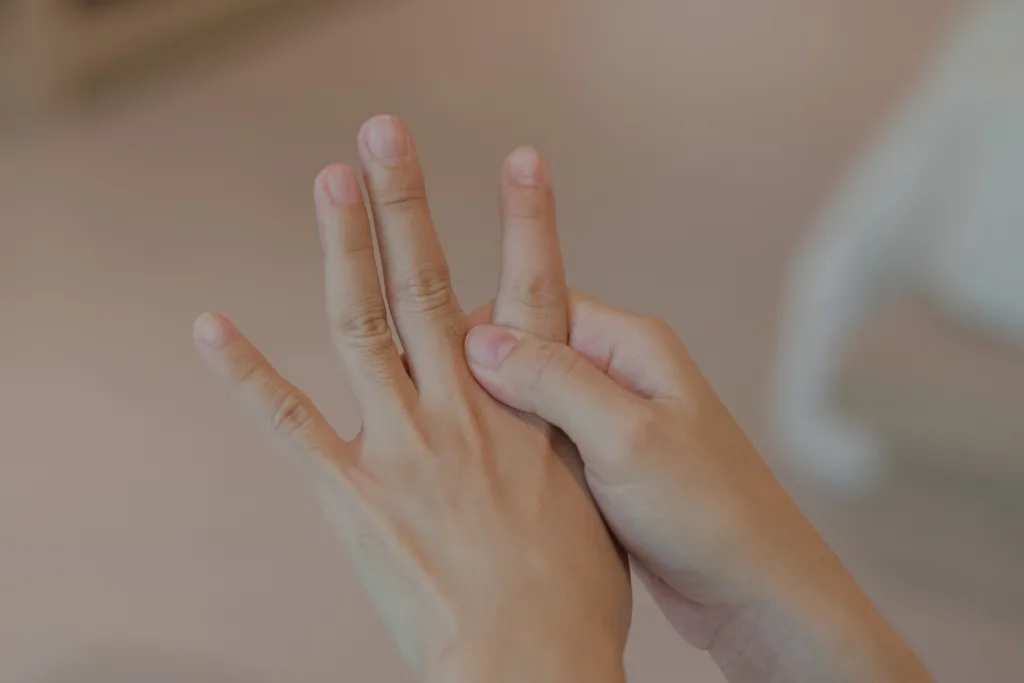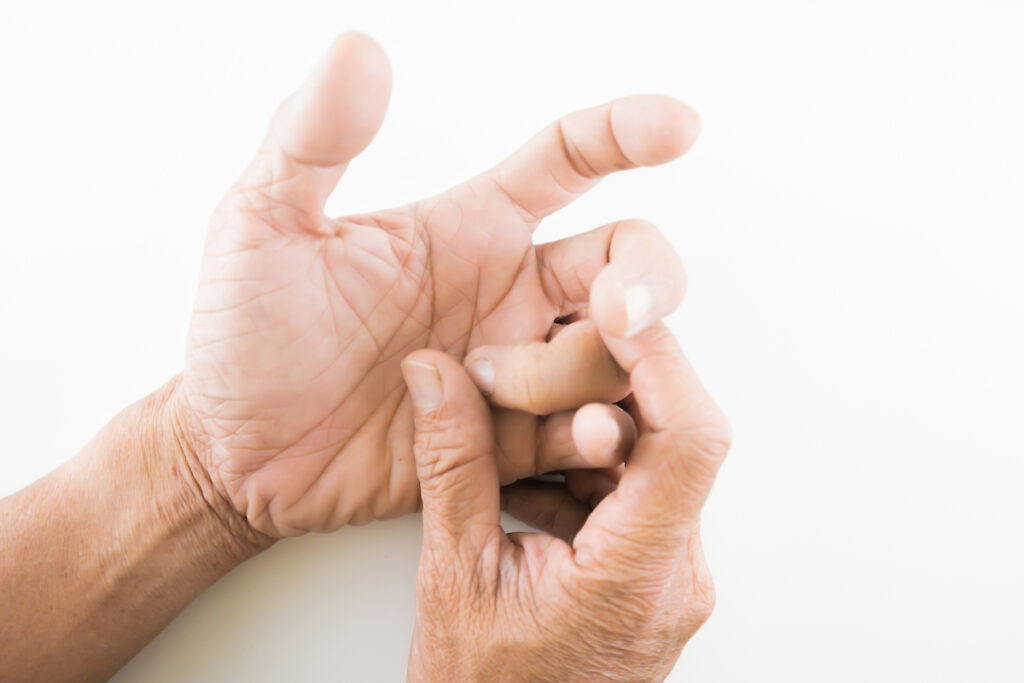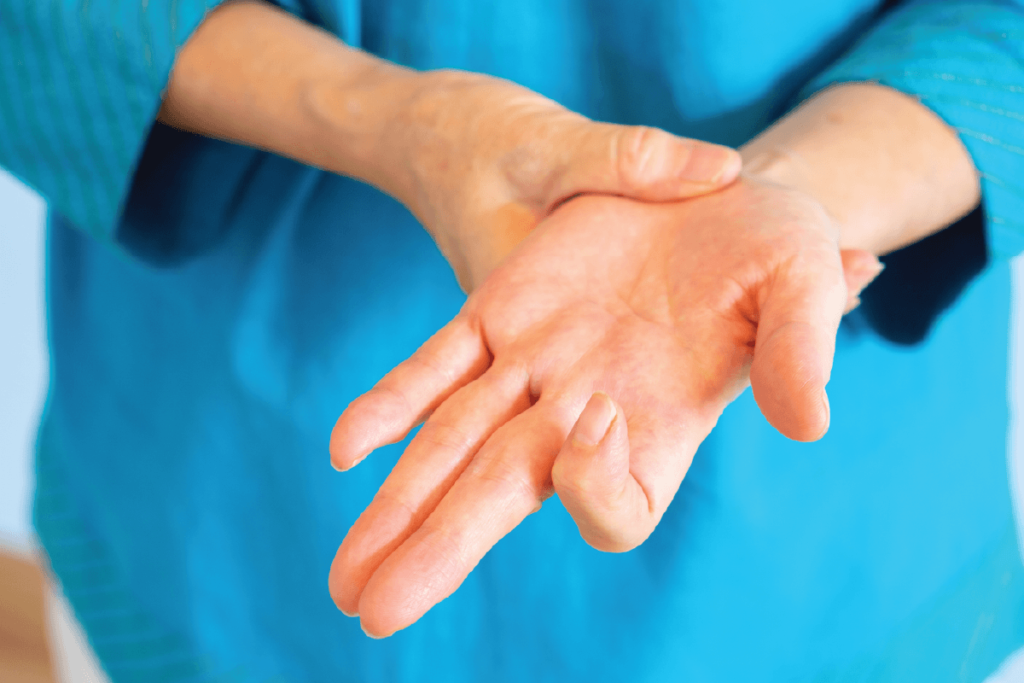If you’re having difficulty bending your finger all the way down, you might be suffering from a condition known as “trigger finger.” This condition, which is caused by a narrowing of the sheath that surrounds the flexor tendons in your fingers, can cause pain and restricted movement.
Your finger may not be able to bend all the way down due to an inflamed tendon or scar tissue buildup around the tendon sheath. This can also cause a clicking sensation as you try to move your finger.
Aside from trigger finger, tere are other medical conditions that can lead to limited motion in your fingers. Arthritis is one such condition that can cause stiffness and limited motion in your fingers due to damage to the cartilage of the joints. Swelling and thickening of the lining of the joints (synovitis) can also lead to restricted movement in your fingers.
Injuries such as strains and sprains can also affect how far your fingers will bend down. If you have injured one of the extensor tendons in your hand, then you may be unable to straighten out one or more of your fingers completely. Similarly, if you have damaged one of the flexor tendons in your hand then you may not be able to bend one or more of your fingers properly. In these cases, there may also be pain and inflammation associated with movement of those affected fingers.
Lastly, Dupuytren contracture is another medical condition that can affect how far down you are able to bend your fingers. This condition is painless but causes knots of tissue under the skin which eventually pull together into a thick cord that keeps some or all of your fingers bent towards the palm of your hand at all times.
If you have difficulty bending one or more fingers all the way down then it is important that you seek medical advice from a professional as soon as possible so they can diagnose what is causing it and suggest appropriate treatment options for relieving any discomfort associated with it. In order to prevent further injury or aggravation it may also be wise to do some gentle stretching exercises specific for improving range-of-motion in those afflicted digits such as placing palm-down on flat surface and gently pressing downwards for 30 seconds before releasing for 4 repetitions per day with each hand.
The Causes of Difficulty in Bending Fingers
Fingers can become difficult to bend due to arthritis, which is characterized by the breakdown of cartilage in the finger joints. This leads to a loss of the normal smooth gliding of the joint, resulting in limited movement and stiffness. Additionally, swelling and thickening of the synovial lining of the joint can lead to further stiffness and difficulty bending. Treatment for this condition may involve medications such as non-steroidal anti-inflammatory drugs (NSAIDs), corticosteroids, or disease-modifying antirheumatic drugs (DMARDs). Physical therapy can also be helpful in increasing range of motion and strengthening surrounding muscles.

Signs of Tendon Damage in the Finger
If you have tendon damage in your finger, you may experience a decreased range of motion in the affected finger. You may also experience pain, tenderness, and swelling in the affected area. Other signs of tendon damage may include loss of strength in the affected finger, difficulty moving the finger, or an inability to straighten or bend certain fingers. If you experience any of these symptoms, it is important to seek medical attention so that a proper diagnosis and treatment plan can be created.
Inability to Extend Fingers
When you can’t extend your finger, it means that your finger is unable to straighten out completely, usualy due to a condition called Dupuytren contracture. This is caused by knots of tissue forming under the skin of the affected fingers, which eventually form a thick cord that pulls the finger into a bent position. This condition is usually painless but can be quite debilitating as it limits the range of movement of the affected fingers. Treatment for Dupuytren contracture involves manual manipulation and/or surgery in order to loosen or remove the thickened cord of tissue, allowing for greater range of motion in the affected fingers.
Signs and Symptoms of a Torn Ligament in the Finger
If you have experienced an injury to your finger joint, it is important to be aware of the signs and symptoms that may indicate you have torn a ligament. These can include: pain in the finger, particularly when moving or touching the injured area; swelling and bruising of the finger shortly aftr the injury; and difficulty or inability to move or straighten the affected joint. In addition, if there is a popping sound or sensation at the time of injury, this can also be indicative of a ligament tear. If any of these symptoms are present, it is important to seek medical attention as soon as possible to ensure that your injury is properly treated.
Treating a Stiff Finger Joint
Stiff finger joints can be loosened through a combination of stretching and strengthening exercises. To stretch the joint, begin by placing your hand palm-down on a table or other flat surface. Gently straighten your fingers as flat as you can against the surface without forcing your joints. Hold for 30 to 60 seconds and then release. Repeat at least four times with each hand. To strengthen the joint, gently squeeze a stress ball or rubber ball in your hand and hold for 5 to 10 seconds. Repeat this 10 times per hand, twice per day. Another exercise involves making a fist and then extending each finger individually, repeating each motion 10 times per hand, twice per day. These exercises should help loosen stiff finger joints over time if done regularly.

Testing for Arthritis in the Hands
In order to test for arthritis in the hands, your healthcare provider will first perform a physical exam of your hands and take X-rays to look for signs of cartilage loss and bone spurs. A blood test may also be ordered to check for markers that indicate rheumatoid arthritis. During the physical exam, your healthcare provider will look for swelling and tenderness in the joints of your hands as well as any difficulty with movement or deformity. The X-ray results will help to determine if there is damage to the bones and cartilage in the hand due to arthritis. The blood test can also detect an autoimmune condition such as rheumatoid arthritis. If needed, oher tests such as MRI scans or ultrasound may be recommended.
Testing for Trigger Finger
To test for Trigger Finger, the doctor will typically perform a physical exam of your hand. During the exam, they will ask you to open and close your hand while they watch for any catching, locking or motion that causes pain. They may also feel for any swelling in the tendon of the affected finger in your palm. Depending on the severity of the condition, imaging tests such as an X-ray or ultrasound may be recommended to further evaluate the affected area and determine a diagnosis.
Signs and Symptoms of a Torn Ligament in the Finger
A torn ligament in the finger is a very painful and debilitating injury. It can cause immediate pain and swelling, as well as intense throbbing or aching in the affected area. You may also experience extreme stiffness and tenderness when you try to move the injured finger. In severe cases, you may even hear a popping sound when the ligament tears.
The Sensation of a Pulled Finger Tendon
A pulled finger tendon can feel like a sharp, shooting pain in the finger that may be accompanied by swelling and tenderness. It can also feel like a pulling sensation or tightness in the affected finger when trying to move or bend it, or when applying pressure to the area. Depending on the severity of the injury, it is possible to have difficulty straightening or bending the finger joint.

Symptoms of a Sprained Finger Tendon
A sprained finger tendon can cause pain and tenderness in the affected area. It may feel like you have a hard time straightening or bending your finger, or it may be difficult to move your finger at all. You may also experience swelling and stiffness in the joint. In some cases, you may even hear a popping noise when you attempt to use the finger. Pain is usually the main symptom, but if there is any bruising or discoloration of the skin surrounding the joint, this could indicate a more severe sprain.
Treating a Stiff Finger
Yes, a stiff finger can be fixed with a combination of treatments. Depending on the underlying cause, medications such as anti-inflammatory drugs may be used to reduce inflammation and pain. Splints or casts can also be used to help improve flexibility in the finger. In some cases, injections may be recommended to reduce stiffness and improve range of motion. Physical therapy including massage, stretches, and strengthening exercises can also help improve flexibility and range of motion in the finger.
The Causes and Symptoms of Mallet Finger
Mallet finger is a type of injury that affects the end of a finger. It is caused by stretching or tearing the tendon that connects the muscle to the finger bone. This results in an inability to fully straighten the end of your finger, causing it to bend inwards towards your palm. Treatment can include wearing a splint or other device to keep the finger straight, as well as physical therapy to strengthen and restore flexibility.
Can Trigger Finger Be Cured?
Yes, trigger finger does usually go away with rest and anti-inflammatory medications. To help the condition improve, it is important to avoid activities that seem to cause or worsen the pain in the affected fingers. Resting your hand and avoiding flexing your fingers can also help the condition improve over a period of a few weeks.

Healing Time for Finger Ligaments
Finger ligaments typically take anywhere from two to 10 weeks to heal. During this period, it is important for patients to actively participate in their rehabilitation program and follow the advice of their healthcare provider in order to ensure a successful recovery. If done correctly, most patients will make a full recovery with no complications. However, some patients may experience re-injury, joint instability, arthritis, or inflammation at the site where the ligament attaches to the bone. It is important that any complications be addressed immediately by a healthcare professional in order to prevent further damage.
Healing Time for a Hyperextended Finger
The healing time for a hyperextended finger depends on the severity of the injury. In most cases, it can take up to two weeks for the swelling to go down and the pain to subside. However, if the injury is more severe, such as a bone fracture or a torn ligament or tendon, you may need surgery followed by physical therapy to restore full motion in your finger. In addition to surgery and physical therapy, it’s important to rest the injured finger and keep it immobilized with a splint or brace during the healing process.
The Risk of Damaging Tendons in Fingers
Yes, it is possible to damage tendons in your finger. This can be caused by a variety of things, such as jamming a finger in a door, crushing a hand in a car accident, or having rheumatoid arthritis. In the case of jamming or crushing injuries, the tendon can be divided or ruptured. If you have rheumatoid arthritis, the inflammation caused by this can lead to rupture of tendons if it is severe enough. Treatment for tendon damage may include rest and immobilization of the affected area with a splint or brace. Physical therapy and/or surgical repair may also be necessry depending on the severity of the injury.
Natural Remedies for Stiff Fingers
A natural remedy for stiff fingers is to apply heat or ice packs to the affected area. Heat increases circulation and can help to reduce pain and stiffness. Ice can reduce inflammation and swelling, whch can also help to alleviate stiffness. Additionally, taking nonsteroidal anti-inflammatory drugs (NSAIDs) such as aspirin can help with pain relief and reduce inflammation. Doing hand exercises to regain mobility is also beneficial in increasing flexibility in the fingers. Applying capsaicin creams or gels, which are derived from chilli peppers, directly onto the affected area may also help to relieve stiffness. Finally, resting the affected area is important for acute injuries or trauma, as this will ensure that it does not become worse.
Unlocking a Locked Finger Joint
To unlock a locked finger joint, begin by gently stretching the finger. You can do this by holding the finger at the base and gently pulling it straight out. If this does not work, you may need to apply a warm compress or massage the joint. To do this, use your fingers to massage around the affected area in a circular motion for several minutes. If you still cannot unlock the joint, you should seek medical advice from your doctor or physical therapist.
Straightening Bent Arthritic Fingers
Yes, you can straighten bent arthritic fingers. Arthritis can cause deformities in the small joints of your fingers, making them look crooked or deviated. Wearing an Oval-8 Finger Splint on the side of the affected joint can help realign and straighten your fingers. The splint is made from a lightweight and durable material, so it’s comfortable to wear all day. Over time, the splint can help to hold the finger in a more natural position and prevent further deformity. Additionally, physical therapy exercises may be recommended to help improve joint mobility and flexibility, which can also help reduce pain and stiffness associted with arthritis.
Conclusion
In conclusion, finger stiffness can be caused by various factors such as damage to the cartilage of the finger joints, swelling and thickening of the lining of the joints (synovitis), damage to extensor and flexor tendons, as well as Dupuytren contracture. Treatment for finger stiffness can involve simple exercises like straightening your fingers against a flat surface and holding for 30-60 seconds. Additionally, if ligaments supporting a finger joint are injured, pain is ofen felt in the finger and it may become swollen or bruised. Taking care of your hands and fingers is essential for avoiding painful and debilitating stiffness.
